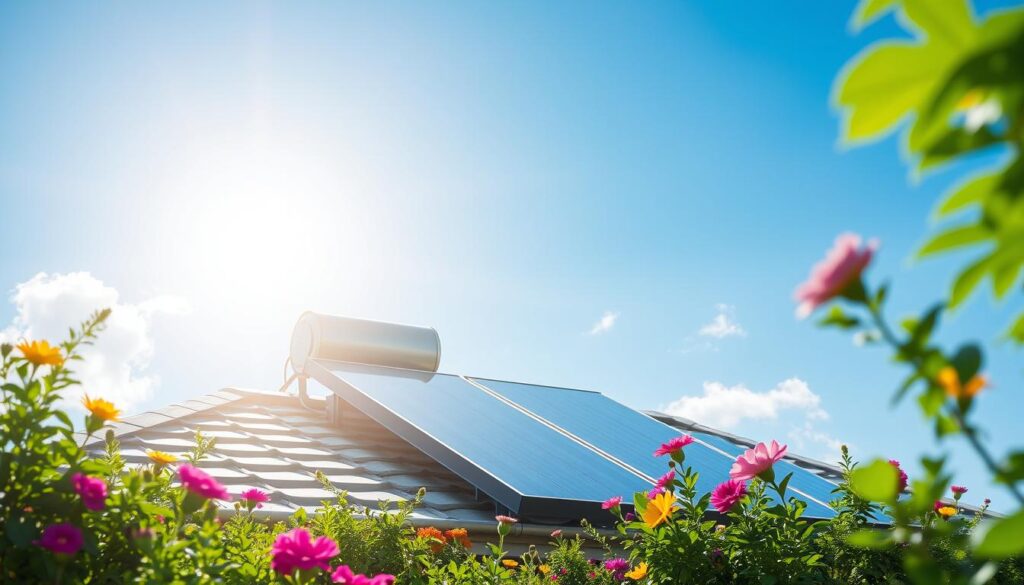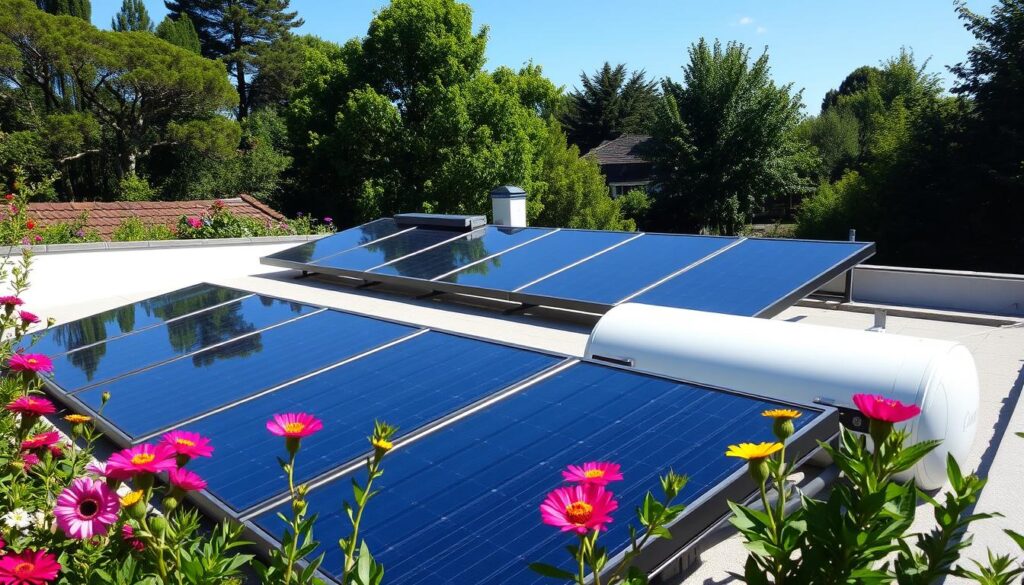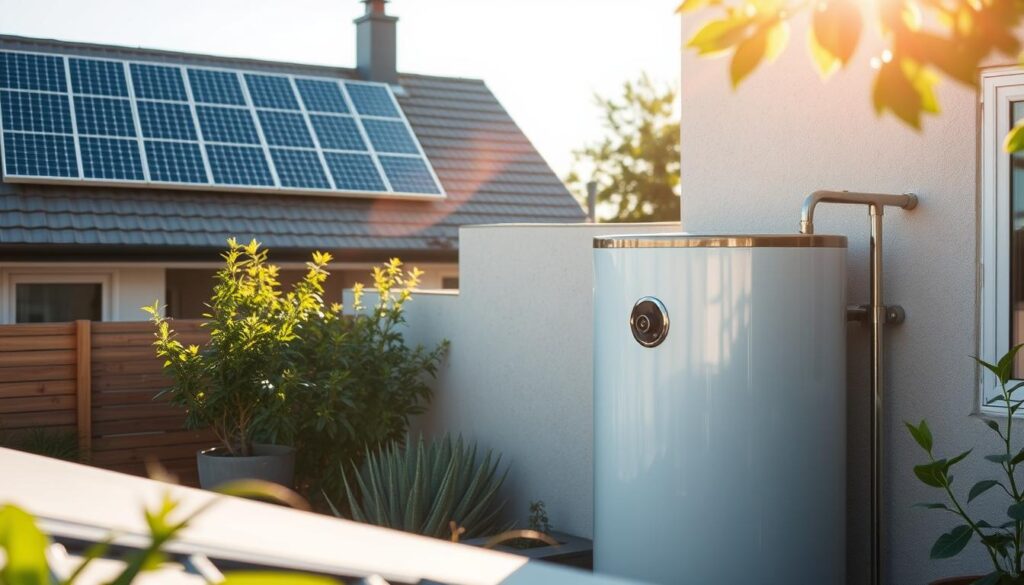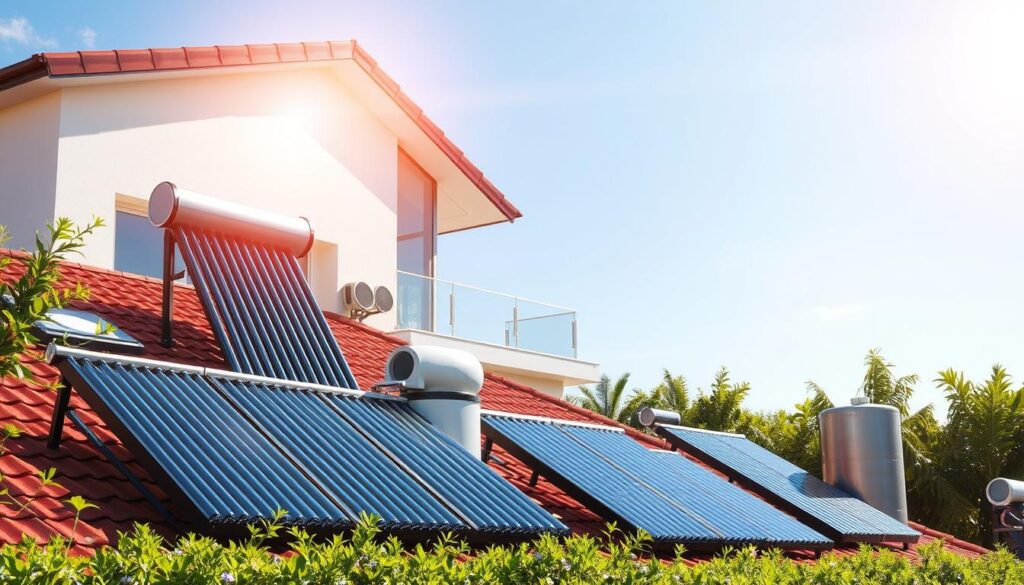Solar powered hot water systems are a cost-effective way to heat water for your home. They work in any climate. Using a solar water heating system can cut your annual hot water costs by up to 50%.
This makes solar powered hot water a smart choice for saving on energy bills. It also helps reduce our use of non-renewable energy. It’s a step towards sustainable water heating and renewable energy.
As more people seek renewable energy, solar powered hot water systems are becoming popular. They offer a sustainable way to heat water for homes and businesses. The best time for them to get sunlight is between 10 AM and 4 PM all year.
This makes them ideal for homes with south-facing roofs. Solar water heaters work best on roofs facing within 30° of true south. This makes them a good choice for many homeowners looking to go solar.

Key Takeaways
- Solar powered hot water systems can reduce annual hot water costs by up to 50%.
- Solar water heaters are a great option for those with south-facing roofs.
- Solar powered hot water systems can be used in any climate, providing a sustainable water heating solution.
- The optimal hours for solar water heating systems to receive direct sunlight are between 10 AM and 4 PM year-round.
- Solar powered hot water systems are a great option for those looking to reduce their energy bills and reliance on non-renewable energy sources, embracing renewable energy.
- Solar water heaters can help reduce our reliance on non-renewable energy sources, providing a renewable energy solution.
Understanding Solar Powered Hot Water Systems
Solar Powered Hot Water Systems help cut down on energy bills and carbon emissions. They use the sun’s heat to warm water, making it a cost-effective way to get hot water. There are two main types: Active Systems and Passive Systems.
Active Systems use pumps and controls to move water. Passive Systems use natural flow to move water. Active Systemsare split into Direct and Indirect types. Direct Systems work well in warm climates, while Indirect Systems are better for cold climates.
Key Components of Solar Powered Hot Water Systems
The main parts of these systems are solar collectors, storage tanks, and backup systems. Solar collectors catch the sun’s heat. Storage tanks hold the warm water. Backup systems, like traditional water heaters, kick in when it’s cloudy or when demand is high.

Passive Systems are cheaper upfront but might not be as efficient. They’re best for places where it rarely gets cold. They’re good for homes that use a lot of hot water during the day and evening. Thermosyphon systems usually hold about 40 gallons of water.
| Type of System | Description |
|---|---|
| Active Systems | Use circulating pumps and controls to circulate water |
| Passive Systems | Rely on natural convection to move water |
| Direct Circulation Systems | Effective in climates with no freezing temperatures |
| Indirect Circulation Systems | Widely used in freezing climates |
In summary, Solar Powered Hot Water Systems are a smart choice for saving on energy and reducing carbon emissions. Knowing the differences between Active and Passive Systems helps homeowners pick the best one for their homes.
The Environmental Impact of Traditional Water Heating
Traditional Water Heating methods harm the environment. They release greenhouse gases and use non-renewable energy. Water heating uses about 18% of a home’s energy, leading to a lot of CO2 emissions.
Renewable Energy, like solar power, can lessen this harm. A solar water heating system can save 1,500 to 3,000 kWh of electricity each year. This means it cuts CO2 emissions by 1 to 2 tons yearly.
Switching to solar-powered hot water systems offers many benefits:
- Less energy use and lower bills
- Smaller carbon footprint and less harm to the environment
- More energy independence and less worry about energy price changes

Using solar water heaters can greatly reduce a home’s Environmental Impact. It helps create a more sustainable future. With solar’s long-term savings and government help, switching to Renewable Energy is easier than ever.
| System Type | Energy Savings | CO2 Emissions Reduction |
|---|---|---|
| Solar Water Heating | 1,500-3,000 kWh/year | 1-2 tons/year |
| Traditional Water Heating | – | 2-3 tons/year |
Benefits of Switching to Solar Hot Water
Switching to Solar Hot Water offers many benefits for homes and businesses. One big plus is the chance to cut down on Energy Bills. The U.S. Department of Energy says a solar water heater can cut water heating costs by 50% to 80%. This is because Solar Hot Water uses the sun’s energy to heat water, needing less traditional energy.
Another big plus is a Lower Carbon Footprint. Using solar power to heat water means using less fossil fuels. This helps lower greenhouse gas emissions. It’s a step towards a more sustainable future and less climate change impact. Some key benefits of Solar Hot Water include:
- Reduced Energy Bills: Solar Hot Water systems can save money on energy bills.
- Lower Carbon Footprint: They use the sun’s energy, cutting down on greenhouse gas emissions.
- Energy Independence: They provide hot water even when the power is out.
Homeowners and businesses might also get Government Incentives for Solar Hot Water systems. These incentives can help cover the cost of installation. With energy costs going up, Solar Hot Water is a smart choice for saving money and helping the planet.

| Benefit | Description |
|---|---|
| Reduced Energy Bills | Solar Hot Water systems can save money on energy bills. |
| Lower Carbon Footprint | They use the sun’s energy, reducing greenhouse gas emissions. |
| Energy Independence | They provide hot water even when the power is out. |
How Solar Powered Hot Water Works
Solar Powered Hot Water systems are a reliable and efficient way to heat water. They include solar collectors and storage tanks. These work together to capture and store the sun’s energy.
The solar collectors are usually on the roof. They absorb the sun’s rays and transfer the heat to the storage tanks. The tanks are well-insulated to keep the water hot.
They can be sized to meet your needs. The best temperature for most systems is between 110°F and 125°F. On sunny days, they can heat water up to 160°F.

In a Solar Powered Hot Water system, the solar collectors heat the water. This water is then stored in the tanks. When you need hot water, it’s drawn from the tanks and delivered to your faucets.
Backup water heaters kick in when the water temperature drops or demand is high. This ensures you always have hot water, even on cloudy days or at night.
Using Solar Powered Hot Water systems has many benefits. They can cut your energy bills and your carbon footprint. By using the sun’s power, you can save up to 65% on water heating energy.
They also help reduce greenhouse gas emissions. You can cut emissions by 1 to 2.5 tonnes per year.
Types of Solar Collectors
Solar Collectors are key in solar-powered hot water systems. There are several types for homes, like Flat Plate Collectors, Evacuated Tube Collectors, and Integral Collector-Storage Systems. Each has its own benefits and drawbacks.
Flat Plate Collectors are very efficient, absorbing almost 98% of sunlight. They’re great for saving on hot water costs, with savings of 60-80%. Brands like SunEarth offer high-quality flat plate collectors, such as the Empire and SunBelt series.
Characteristics of Solar Collectors
Evacuated Tube Collectors work well in cold temperatures, down to -40°F. They can also reach high temperatures, up to 480°F. This makes them perfect for colder climates and commercial use.
Choosing the right solar collector is important for your home’s needs. Look at efficiency, durability, and plumbing system compatibility. This ensures a reliable and efficient solar hot water system.

Comparison of Solar Collectors
| Type of Collector | Efficiency | Temperature Range | Applications |
|---|---|---|---|
| Flat Plate Collectors | 98% | Up to 200°F | Residential, Commercial |
| Evacuated Tube Collectors | 90-95% | -40°F to 480°F | Residential, Commercial, Industrial |
In conclusion, Solar Collectors are essential for solar hot water systems. Picking the right one is key for efficiency and effectiveness. By understanding each type’s characteristics, you can choose wisely and enjoy solar hot water at home.
Cost Considerations and ROI
Thinking about getting a solar hot water system? Cost considerations are key. The initial cost is about $9,000 before any rebates or incentives. But, it’s worth looking at the long-term savings and the ROI on your investment.
Solar hot water systems can save a lot on your water heating bills. They produce around 64.3 gallons of hot water daily. This means less need for traditional energy, which can cut your bills. For instance, natural gas heating costs between $149.83 and $257.52 a year. Electric water heating can cost up to $457.54 annually.
Several factors impact the cost considerations and ROI of solar hot water systems:
- Local climate conditions: Sunny areas save more as backup systems are used less.
- System maintenance: These systems can last over 20 years with little upkeep.
- Upfront installation cost: The initial cost can be lowered by rebates, incentives, and long-term savings.
Also, solar hot water systems are good for the environment. They use a zero-emissions renewable resource. By choosing solar hot water, you help the planet and enjoy big energy savings and a strong ROI on your investment.

Installation Requirements and Process
Installing a Solar Hot Water system requires careful planning. A Site Assessment is key to check if it’s possible. This looks at the sun’s strength, weather, and local building rules.
The system needs a south-facing roof with enough room for the solar collectors. Putting in a whole system usually takes 2 to 3 days. But, it depends on how complex the system is and the home’s details.
Important things to think about during installation include:
- Permitting Requirements: making sure you follow local building codes and safety rules
- Professional vs DIY Installation: deciding if you should hire someone or do it yourself
- System Sizing: figuring out the right size for the solar storage tank and collector area
A good installation makes the Solar Hot Water system work better. Regular checks, like annual inspections, can boost efficiency by 10%-15%.

| System Component | Description |
|---|---|
| Solar Collectors | Convert sunlight into heat energy |
| Solar Storage Tank | Stores heated water for later use |
| Backup System | Provides supplemental heat when needed |
Sizing Your Solar Hot Water System
To make your solar hot water system work well, you need to get the right size. Energy Efficiency is key, and the right size matters a lot. The size depends on your climate, how much water you use, and the type of collectors.
Flat-plate collectors come in sizes from 20 to 48 square feet. They can weigh between 80 to 150 pounds.
For sizing, a good rule is 20 square feet of collector area for the first two people. Add 12 to 14 square feet for each extra person. The storage tank size is usually 20 gallons per person per day. For active systems, you need 1.5 gallons of storage per square foot of collector area.
Getting the System Sizing right is important for the best Solar Hot Water performance and energy use.

| Number of People | Recommended Storage Tank Volume |
|---|---|
| 1 to 3 people | 30 to 60 gallons |
| 3 to 4 people | 80 gallons |
| 4 to 6 people | 120 gallons |
By following these guidelines, you can make sure your solar hot water system fits your needs. This will help you use energy more efficiently and get the most out of your Solar Hot Water system.
Integration with Existing Systems
Integrating solar hot water systems with existing ones requires careful thought. A key factor is the need for a backup heating system. This is because solar water heating systems need a backup for cloudy days and when demand is high.
There are different ways to integrate solar hot water systems with existing ones. For example, they can be paired with conventional storage water heaters or tankless water heaters. The choice of backup system depends on the solar system’s size, climate, and hot water use.
Benefits of integrating solar hot water systems include lower energy bills and a smaller carbon footprint. Plus, many states offer financial perks like sales tax exemptions and income tax credits for solar systems.

Choosing the right storage tank is critical. It should match the solar system and meet the household’s hot water needs. It also needs insulation to reduce heat loss. Common tanks include flat-plate collectors, evacuated tube collectors, and integral collector-storage systems.
Backup heating options are also important. Choices include conventional water heaters, tankless water heaters, and heat pumps. The right choice depends on the solar system’s size, climate, and hot water use.
Maintenance and Care
Keeping your Solar Hot Water system in good shape is key. Regular checks can spot issues early. Look for leaks, clean the solar panels, and check the glass for damage.
A well-kept system saves money and cuts down on carbon emissions. To keep it running well, check fluid levels and pressure monthly. The U.S. Department of Energy says cleaning solar panels can boost energy output by 5-10%.
Some important maintenance tasks include:
- Check the solar collectors three times a year for shading or debris
- Look at the collector support structures for loose nuts and signs of rust
- Check the duct insulation for damage and cover it with plastic or aluminum if needed
- Make sure the pressure relief valve on liquid solar heating collectors works right
By following these tips, you can make your Solar Hot Water system last longer. Regular checks also help find problems early, saving you money and energy.

Common Challenges and Solutions
Solar Hot Water systems face challenges like freezing temperatures and extreme weather. To tackle these, regular maintenance and inspections are key.
Issues like corrosion, scaling, and leaks can harm the system’s performance. Using quality materials and regular cleaning can help. Fixing problems quickly is also important.

Regular checks and maintenance are vital for Solar Hot Water systems. This includes looking for leaks, cleaning, and replacing old parts. Taking these steps helps avoid problems and saves energy and money.
Effective ways to handle common issues include:
- Regular maintenance and inspections
- Using high-quality materials and equipment
- Addressing issues promptly to prevent system failures
- Implementing energy-efficient practices to minimize energy consumption
Knowing the challenges and using good solutions helps homeowners enjoy Solar Hot Water. With the right care, these systems can provide hot water efficiently for many years.
Climate Considerations and Efficiency
Solar Hot Water systems work in any climate. But, their performance can change based on temperature and sunlight. The efficiency of these systems is key to their success and value.
In general, these systems do best in places with lots of sunlight and moderate temperatures. To get the most out of your system, pick the right one for your climate. For example, active systems are good for cold places, while passive ones work better in warm areas.
Regular upkeep is also vital. This includes cleaning the solar collectors and checking the heat transfer fluid. This keeps your system running smoothly and efficiently.
Here are some tips for making your Solar Hot Water system work better in different climates:
- Opt for a system with high solar collector efficiency for cloudy or low-sunlight areas.
- Choose a system with a well-insulated storage tank to keep heat in during cold weather.
- Think about adding a backup heating system, like a heat pump or electric water heater, for when sunlight is scarce.

In summary, Solar Hot Water systems are a smart choice for any climate. Just make sure to pick the right one and take care of it. By doing this, you can enjoy the benefits of Solar Hot Water while helping the environment.
| Climate Zone | Solar Hot Water System Type | Efficiency |
|---|---|---|
| Temperate | Active | High |
| Tropical | Passive | Medium |
| Cold | Active | Low |
Comparing Different Solar Hot Water Brands
Choosing a solar hot water system can be tough with so many brands out there. We’ll look at top manufacturers, price ranges, and warranties. This will help you make a better choice.
Top brands like Sunbank, Rheem, and Apricus offer a variety of systems. They range from passive to active, providing efficient and affordable options for homes.
Top Manufacturers
- Sunbank: Known for their high-quality and affordable solar water heaters
- Rheem: Offers a range of solar hot water systems, including passive and active systems
- Apricus: Provides innovative and efficient solar hot water solutions
Price Ranges
The cost of a solar hot water system varies. A 100-litre system costs between $1,500 to $2,500. A 200-litre system costs between $2,500 to $4,000.

Warranty Information
Warranty is key when picking a solar hot water system. Most brands offer a 5-10 year warranty. Always check the warranty terms before buying.
| Brand | Model | Price Range | Warranty |
|---|---|---|---|
| Sunbank | 40 Gallon Solar Water Heater | $1,500 – $2,500 | 5 years |
| Rheem | 100L Solar Hot Water System | $2,000 – $3,500 | 7 years |
| Apricus | 200L Solar Water Heater | $3,000 – $4,500 | 10 years |
Real-World Performance Data
When looking at Solar Hot Water systems, performance is key. Performance Data gives us insights into how well these systems work. By checking Case Studies and what happy customers say, we learn a lot.
A study on the Sunbank 40 gallon solar water heater shows its strength. It’s efficient and saves money, with an average irradiance of 634.90 W/m² and a solar thermal efficiency of 24.67%. These numbers show how Solar Hot Water can cut down on energy costs and carbon emissions.
Here are some key findings from the study:
- Average irradiance values: 634.90 W/m², 625.90 W/m², and 636.30 W/m²
- Solar thermal efficiency: 24.67%, 34.40%, and 49.95%
- Mean ambient temperatures: 21.10 °C, 21.70 °C, and 20.70 °C

These results show why Performance Data matters for Solar Hot Water systems. By looking at Case Studies and what people say, we understand how they work in real life. This helps us make smart choices about using them.
| Parameter | Value |
|---|---|
| Average irradiance | 634.90 W/m² |
| Solar thermal efficiency | 24.67% |
| Mean ambient temperature | 21.10 °C |
Future of Solar Hot Water Technology
The future of Solar Hot Water technology looks bright. Innovations are making these systems more efficient and affordable. As we move towards renewable energy, Solar Hot Water systems are becoming more popular. They can meet 50-80% of our hot water needs, cutting down energy use and carbon emissions.
New advancements in Solar Hot Water technology include better solar collectors and storage systems. These improvements will help homes save more energy and use less traditional heating. Plus, combining Solar Hot Water with other green energy sources and appliances will boost its benefits even more.

- Reduced energy bills: Solar Hot Water systems can save households around $140 per year on water costs.
- Lower carbon footprint: Solar Hot Water systems can offset several tons of CO2 emissions over their lifetime.
- Increased energy independence: Solar Hot Water systems can supply a significant portion of domestic hot water needs, reducing reliance on traditional energy sources.
As more people want Solar Hot Water systems, we’ll see even more progress in the future.
| Benefit | Description |
|---|---|
| Energy Savings | Solar Hot Water systems can save households around $140 per year on water costs. |
| Environmental Impact | Solar Hot Water systems can offset several tons of CO2 emissions over their lifetime. |
| Energy Independence | Solar Hot Water systems can supply a significant portion of domestic hot water needs, reducing reliance on traditional energy sources. |
Conclusion
Solar-powered hot water systems are a promising, sustainable choice for homes and businesses. They use the sun’s energy to heat water, cutting down on energy bills and carbon emissions.
Studies show solar water heaters can turn up to 80% of sunlight into heat. Switching can save 50% to 80% on water heating costs. Plus, government incentives and tax credits make the initial cost lower.
The future of solar-powered hot water looks bright. Advances in tech will lead to better efficiency, smart home integration, and lower costs. Embracing this renewable energy helps us build a greener future.
If you’re ready to enjoy solar-powered hot water, now’s the time to start. It’s a step towards energy independence and a greener lifestyle. The benefits are worth the effort.
FAQ
What are the different types of solar-powered hot water systems?
Solar-powered hot water systems come in two main types: active and passive. They can also be direct or indirect.
What are the environmental benefits of switching to solar-powered hot water?
Switching to solar-powered hot water reduces greenhouse gas emissions. It also cuts down on non-renewable energy use. This helps make our future more sustainable.
What are the key components of a solar-powered hot water system?
A solar-powered hot water system has three main parts. These are solar collectors, storage tanks, and a circulation system.
How can solar-powered hot water systems help reduce energy bills?
Solar-powered hot water systems offer a green way to get hot water. This reduces the need for energy from non-renewable sources. It can lower your energy bills.
What are the different types of solar collectors available?
There are several types of solar collectors. These include flat plate collectors, evacuated tube collectors, and integral collector-storage systems.
What are the cost considerations and return on investment (ROI) for solar-powered hot water systems?
Solar-powered hot water systems can be expensive upfront. But, they offer long-term savings and benefits. This can make them a good investment.
What are the installation requirements and process for solar-powered hot water systems?
Installing a solar-powered hot water system involves several steps. These include assessing the site, getting permits, and choosing between professional or DIY installation.
How do you size a solar-powered hot water system correctly?
Sizing a solar-powered hot water system right is key. It depends on climate, water use, and energy efficiency.
How do you integrate a solar-powered hot water system with existing systems?
Integrating a solar-powered hot water system with existing systems requires careful planning. You need to consider backup heating and storage tank needs.
What are the common challenges and solutions for solar-powered hot water systems?
Solar-powered hot water systems face challenges like weather issues and performance optimization. Troubleshooting is also common. But, there are solutions for these problems.
How do climate considerations affect the efficiency of solar-powered hot water systems?
Climate can greatly affect the efficiency of solar-powered hot water systems. It’s important to choose the right system for your climate.
How do you compare different solar hot water brands?
When comparing solar hot water brands, look at top manufacturers, price ranges, and warranties. This helps you make an informed choice.
What kind of real-world performance data is available for solar-powered hot water systems?
There’s real-world data on solar-powered hot water systems. This includes case studies and testimonials. They offer insights into system effectiveness.
What is the future of solar hot water technology?
Solar hot water technology is evolving. New innovations and smart integration are on the horizon. These advancements will improve system efficiency and performance.